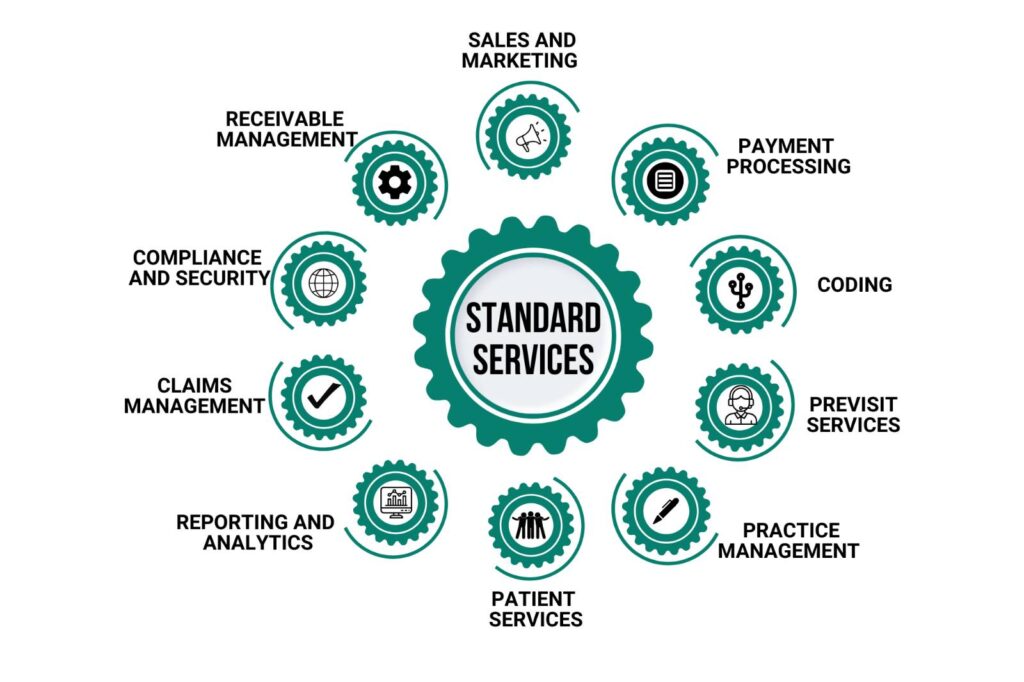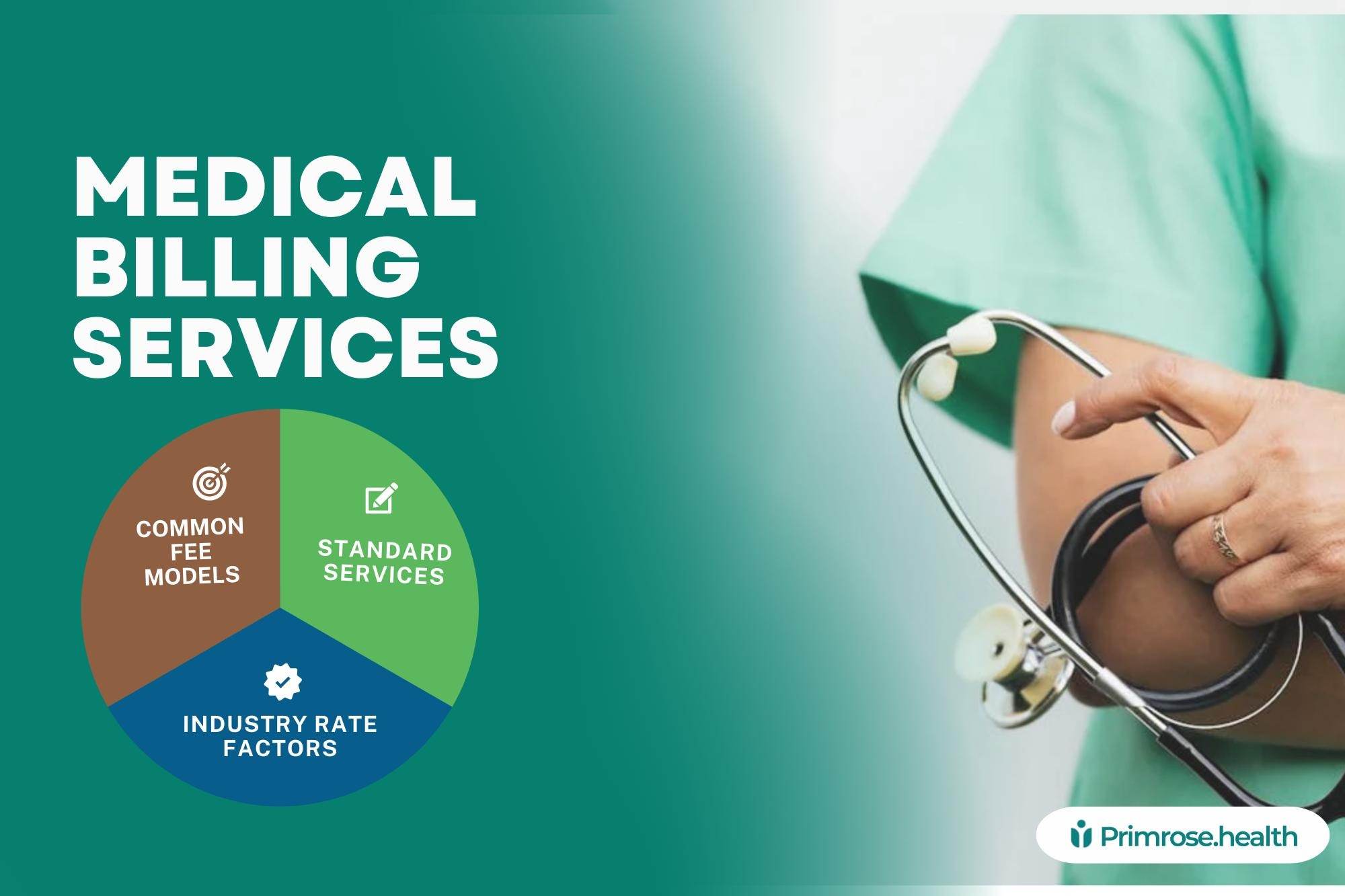Medical billing services cover different fee models, typical costs, and the various services included in medical billing arrangements.
1. Percentage-Based Model
Medical billing services usually charge by taking a percentage of the revenue collected. This percentage falls between 5% and 10% of the paid claims but it can vary depending on several factors.
– Practice specialty (with complex specialties commanding higher percentages)
– Claims volume
– Average claim value
– Geographical location
– Level of service required
Advantages:
– Aligns billing service success with practice revenue
– No upfront costs
– Motivates the billing service to maximize collections
– Predictable costs as a proportion of revenue
Disadvantages:
– Can be expensive for high-revenue practices
– May not be cost-effective for practices with very high-value claims
– Potential for billing services to prioritize higher-value claims
2. Per-Claim Fee Model
Some billing services just charge a consistent rate per claim, usually around $4 to $7. This fee can vary for primary and secondary claims.
Advantages:
– Predictable costs
– Potentially more cost-effective for practices with high-value claims
– Transparent pricing structure
Disadvantages:
– Costs remain the same regardless of collection success
– May not incentivize maximum collection efforts
– Can become expensive with high claim volumes
3. Hybrid Models
Some services combine percentage-based and per-claim fees, often with lower percentages and reduced per-claim costs. These models might include:
– Base fee plus reduced percentage
– Tiered pricing based on claim volume
– Different rates for different types of services
Standard Services Included

Most medical billing services provide a core package of services that includes:
1. Claims Management
– Enter Demographics & Insurance Information
– Claim scrubbing
– Electronic and paper claim filing
– Claims tracking and follow-up
– Secondary claim submission
2. Payment Processing
– Insurance Payment posting
– EOB (Explanation of Benefits) processing
– Bank Reconciliation
– Patient payment processing
– Credit card payment processing
3. Receivable Management
– Manage Denials
– Manage Rejections
– Appeals claims
– Patient, facility or provider communication
– Manage Aging reports
4. Reporting and Analytics
Monthly financial reports
– Claims status reports
– Collection rate analytics
– Aging report
– Provider productivity reports
5. Patient Services
– Online payment portal
– Statement generation & mailing
– Answer patient billing inquiries
– Dunning Services
– Work with Collection Agencies
6. Previsit services
– Appointment Scheduling
– Appointment Reminders
– New Patient Registration
– Eligibility verifications
– Service fee estimations
7. Coding
– E&M, Procedure & Surgery coding
– Quarterly Coding Audits
– Feedback to providers
8. Practice Management
9. Sales & Marketing
– Manage Google Reviews
– Manage Social media accounts
– Market to Referring providers
10. Compliance and Security
– HIPAA compliance
– IT Security audits
– Compliance training
– Documentation review
– Coding compliance checks
Industry Rate Factors
Several factors influence the rates charged by medical billing services:
Practice Size
– Small practices (1-3 providers): Usually pay higher percentages (7-10%)
– Medium practices (4-10 providers): Moderate percentages (6-8%)
– Large practices (11+ providers): Often negotiate lower rates (5-7%)
Specialty
– Primary care: Lower rates (5-7%)
– Specialized practices: Higher rates (7-9%)
– Complex specialties (e.g., surgery, oncology): Highest rates (8-10%)
Geographical Location
– Urban areas: Generally higher rates due to operating costs
– Rural areas: Often lower rates but fewer service providers
– Regional market competition can significantly impact rates
Setup Fees
– Initial implementation: $500-$3000
– Software integration: $200-$1000
– Training: $200-$500 per staff member
Additional Service Fees
– Credentialing: $500-$1000 per provider
– Prior authorization: $15-$25 per authorization
– Patient statements: $1-$2 per statement
– Coding reviews: $50-$100 per hour
Choosing the Right Model
Healthcare providers should consider several factors when selecting a billing service model:
Practice Considerations
– Monthly claims volume
– Average claim value
– Current collection rate
– Staff resources
– Technology infrastructure
Service Provider Evaluation
– Experience with similar practices
– Technology capabilities
– References and reputation
– Financial stability
– Support services
Conclusion
The cost of medical billing services varies significantly based on multiple factors, but most practices can expect to pay between 5% and 10% of collections or $4-$7 per claim. When selecting a service provider and fee model, practices should carefully evaluate their specific needs, volume, and specialty requirements. The right combination of services and pricing model can significantly impact a practice’s bottom line while improving operational efficiency.
Understanding the full scope of services included, potential additional costs, and the factors that influence pricing can help practices make informed decisions about their medical billing arrangements. Regular review of billing service performance and costs can ensure the chosen model continues to meet the practice’s needs effectively.
